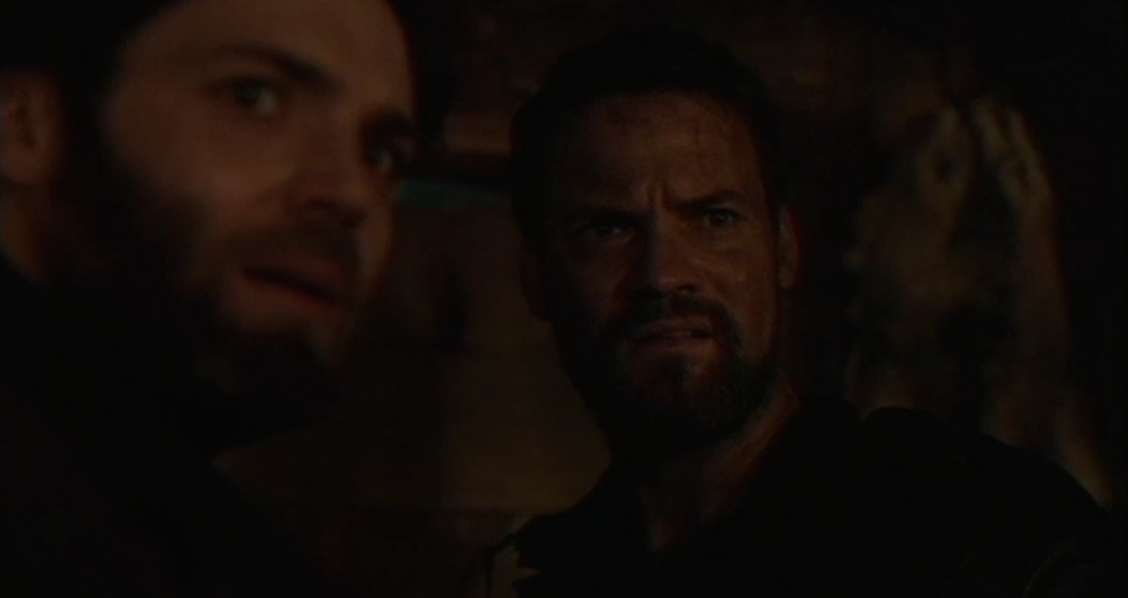Reviews
[TV Review] “Salem” Episode 2.10: ‘Til Death Do Us Part’

Remember that time Lucy Lawless made out with a six-year-old? Yeah, it was pretty disturbing. You can’t really say Salem isn’t afraid to “go there” once a 47-year-old woman makes out with a six-year-old. Anyway, Salem was going a mile-a-minute this week. It was disappointing to find out that Marburg has three nights to attempt Baby John’s baptism by hellfire, so I can only assume the next two episodes will be the next two attempts. Hopefully I’m wrong, as Salem has a way of subverting my expectations, but if that is the case it could become redundant. Nevertheless, this was still a strong episode for the series, as the pieces moved closer together on the chessboard.
The best part of the episode is that all of the characters are all fully embroiled in Marburg’s plot, now that Hathorne appears to be one of her henchman. The plus side is that Cotton and John are now on Mary’s side (at least temporarily). The sight of him begging at her feet was a surprising turn for the character, as it seemed like he would be too proud to stoop to such levels.
It really appeared as if Marburg was going to meet her end tonight, which would have been extremely surprising. Alas, it was not meant to be as she was able to get her relict back from Mary. The hiding place of the relict was the same place Marburg talked to a bathing Anne way back in the season’s second episode. It had some insane security protecting it though, didn’t it? Isaac was revealed to be alive as well, which is wonderful. He was the heart of most of the first season (since Mary wasn’t very sympathetic back then), so it’s refreshing to know that he is alive (and will probably be killing Mercy soon).
Oh but how Mary will regret attempting to foil the Countess’ plan. She may have rescued Baby John (for now), but Marburg showed just how vindictive she could be. I thought George’s body was going to turn up, but it turns out she was arrested by Hathorne for sleeping with Wainright! Way to pull the rug out from under us Salem. It was too easy for Mary to get the relict, so something had to happen since we still have (only) three episodes left in the season.
Mary and Alden were able to continue their conversation from last week, as she explained to him why she became a witch (other than the whole unmarried pregnant woman thing). Her asking him for forgiveness was a nice moment of emotional nakedness from Janet Montgomery. Shane West also did some good work here, and it was nice to see Alden open to the idea of forgiveness.
Anne and Cotton also had a big moment this week, as they got married! The issue here is that Cotton is still under her love spell, so Anne is a bit delusional in thinking that any of it is authentic. It was nice to see Cotton call out Hathorne for arranging his attempted murder, though. Man I hate that guy.
Now we get to my big gripe with the episode, and it’s more a matter of personal sub-genre tastes. I’m just not a fan of possessed Baby John. The image of him with his head spinning before is pretty standard for the demon child sub-genre. As well is said child saying grotesque things, though him mentioning playing cat’s cradle with Cotton’s and John’s entrails made me chuckle. There’s just not much more that can be done with the sub-genre to make it feel fresh, so Salem has a daunting task ahead of itself. Baby John has been one of the least interesting parts of the season and it’s difficult to care for him now that he’s possessed. Maybe I’m just being a Debbie Downer here. What do you think?
Random Notes
- No Tituba this week. Pity.
- The look on John’s and Cotton’s faces when Baby John went all demon-y was a great moment of WTF realness from the actors.
- Isaac crying over Dottie’s corpse killed me.
- So that was the Devil himself tormenting Anne last week. It’s an interesting (read: fucking creepy) interpretation of the character.
- Mary and Alden just need to fuck and get it over with.
- I never in a million years thought I would say this but: Where’s Mercy?
- Loved Marburg’s tweak on the “Rock-a-bye-Baby” nursery rhyme (the baby drowns in the end).
- “Find it, destroy it, and the bitch can be run through with a dull blade.” -Mary, on the corpse Marburg keeps aboard her ship.
- “I have loved you in ways no woman ever has.” -Marburg to Sebastian. Gross.
- “You know I saw her once. Mousy little thing. I don’t know why the…Lord chose her.” -Marburg on the Virgin Mary.
- “My heart? You’re welcome to it. But I think it might be a little bitter for your taste.” -If I could just have a bottle episode of Mary and Marburg locked in a room trading quips I would be 100% satisfied and give the episode a 5/5 before even seeing it.
- “I will certainly try, Mrs. Mather.” -Not a funny line, but it was really sweet. My colleague Bree Ogden seems to think Cotton will die before the season ends. I disagree.

Reviews
‘Clue: A New Comedy’ Stage Play Is a Slapstick Slasher That Lovingly Adapts Hasbro’s Board Game

The national tour of ‘Clue: A New Comedy’ remixes the classic murder mystery with farcical physical comedy and impassioned old-fashioned sensibilities.
“It’s all part of the game.”
There’s a strong relationship between mischievous murder mysteries and the horror genre. Murder mysteries inherently hinge upon death – it’s baked into the name – so it’s not surprising that horror has embraced this secretive subgenre and really emphasized the murder in murder mysteries. Murder mysteries have been popular in pop culture for nearly a century. However, there’s been a recent renaissance on this front with playful films like Knives Out, A Haunting in Venice, Bodies Bodies Bodies, the Scream franchise, and the prominence of the true-crime genre and armchair detectives. That being said, an underrated and evergreen source of murder mystery hijinks that’s entertained audiences for 75 years is Hasbro and Parker Brothers’ Clue.
Clue has experienced many permutations over the years, including Jonathan Lynn’s 1985 cult classic film and several stage adaptations. In a new dawn where board game and toy IP are at an all-time high, a new stage adaptation of Clue has been put together by Sandy Rustin, with additional material by Hunter Foster and Eric Price, and directed by Casey Hushion. Hushion’s Clue: A New Comedy, which is in the middle of a national tour, effortlessly harkens back to vaudevillian silliness and broad laughs, while it simultaneously explores darker genre impulses and intrigue. It’s the perfect way to nostalgically celebrate the ’80s movie, but also remind audiences why Hasbro’s upcoming cinematic remake is long overdue.
Hushion’s Clue is an adaptation of Lynn’s ‘85 film, but it still brings many original ideas and revisions to the table so that this doesn’t just feel like a stripped down version of the movie. Clue: A New Comedy finds immense pleasure in how it translates the game’s rules so that it functions as a faithful adaptation of the game and the feature film, while it also becomes a fun, fresh entity that’s a living hybrid of both. In Clue: A New Comedy, blackmail functions as the story’s central mystery, just as it does in the board game and cinematic adaptation. Each color-coded houseguest has terrible secrets that they don’t want getting out, which becomes the impetus for the growing body count.
Clue is a comedic character study and this stage play presents well-defined individuals who are easy to identify and connect with, despite their one-dimensional nature. Mr. Green (John Shartzer) is the cast’s real standout, but there’s not a single weak link among Clue’s eight central players. Clue’s best moments are the ones when the whole cast gets to bounce off of each other and revel in the group’s chaotic energy. The play’s ‘50s McCarthyism setting also adds an extra layer of mistrust, paranoia, and subterfuge to the equation that still feels timely in its own way. Farcical, broad wordplay – especially from John Treacy Egan’s Colonel Mustard – are a delight and reminiscent of an old-fashioned radio play when it comes to Clue’s jokes, timing, and dialogue.
Beyond Clue’s script lies some exceptional physical comedy, particularly from Shartzer’s Mr. Green. There are broad group reactions that play out in unison for mass comic effect, as well as lighting cues that brilliantly accentuate punchlines and become a solid running gag throughout the 90-minute show. There are playful movement exercises that are expertly choreographed and verge on interpretative dance. Clue adopts a real Scooby-Doo energy to the production, especially when it comes to its scene transitions. Clue even indulges in a “multiple door chase sequence” that taps into the right energy for this degree of slapstick. To this point, there’s an absolutely brilliant slow motion sequence that’s a highlight of the show and adeptly incorporated.
Clue’s characters are its secret weapon, but stellar production elements help elevate the stage play to something truly special. There’s really powerful set design by Lee Savage that evokes a creepy, cozy Haunted Mansion aesthetic that’s the right atmosphere for this murder mystery tale. Clever design decisions result in rotating walls and rooms that economically get the most out of the stage’s environment. Clumsy execution of these elements would quickly sink Clue and ruin its crescendoing quality. They’re seamlessly handled, as are Ryan O’Gara’s evocative lighting design and Michael Holland’s jauntily creepy musical cues. All these elements work together to make sure that Clue is as visually entertaining as it is well-acted and written.
Clue: A New Comedy goes all-in on its laughs. That being said, the play’s death scenes are actually creepy and immaculately orchestrated with all the finesse of peak genre cinema. There are genuine slasher vibes present that pulse through the show’s pervasive slapstick silliness. It’s a testament to the sheer artistry of craft in Clue that both of these extremes work as well as they do. Clue also shrewdly embraces the infamous multiple ending angle that helped give Lynn’s feature film a smart extra meta layer to its storytelling. It’s fun, different, and takes advantage of the medium of theater to great effect. It’s also the satisfying culmination of a story that gets progressively manic, unhinged, and verges on collapsing in on itself by the end – but in the best way possible. Clue pushes boundaries with tone and control like an expert puppet master.
Clue: A New Comedy hits all the right notes and succeeds as a breezy piece of theater that celebrates whodunit hijinks, broad buffoonery, and wicked wit. It’s Agatha Christie meets Frasier. Clue is a show that definitely prioritizes comedy over horror and suspense, but there’s enough style in this production to properly sell the production’s more evil impulses. It’s unlikely that anyone will be genuinely frightened, yet the play will still keep audiences on the edge of their seats and eagerly anticipate who’s responsible for Boddy Mansion’s copious corpses. Clue: A New Comedy is the best way to experience the Hasbro and Parker Brothers classic before its next cinematic adaptation proves that murder and mayhem aren’t just a game anymore.
Go to Broadway.org to see if ‘Clue: A New Comedy’ will be coming to your area.


Photo by Evan Zimmerman for MurphyMade














You must be logged in to post a comment.